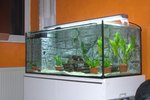
You need to add calcium to your aquarium only if you keep invertebrates that absorb it to make their shells and exoskeletons, like corals. If you need to add calcium to your aquarium, options vary. One, calcium chloride, takes a bit of effort. However, if you do it properly, you can replace the calcium your corals have absorbed.
Dissolve
You can theoretically dump calcium chloride directly into the aquarium or sump. However, it is very easy to overdose the tank if you do things this way. This can wreak all manner of havoc on water chemistry, causing issues with pH and alkalinity in addition to calcium levels. It is much safer to pre-dissolve calcium chloride and let it slowly drip into the aquarium. This method requires a bit of DIY skill but will give you better, safer results.
Drip System Supplies
In order to build a drip system, you will need a few common supplies. You can get them at most pet shops and hardware stores. You will need a clean 8-ounce water bottle, rigid tubing and flexible tubing. If you purchase your flexible tubing at a hardware store, it might sell under the name 3/16th-inch flexible tubing. Additionally, you will need a air line tubing valve, available at most pet shops. Metal valves will corrode, so get a plastic one. If you want to get really fancy, you can get a rolling IV drip regulator online in lieu of an airline tubing valve.
Drilling the Lid
To assemble the drip system, start by drilling two holes in the water bottle's lid. Put the lid open-side-up on top of a surface you can drill into. Ideally, drill a very small pilot hole, then drill a hole slightly smaller than the outer diameter of the rigid tubing. Make sure you position the holes as far as you can from the edge of the lid so it can still screw shut tightly. These holes should be just large enough to let you wedge the rigid airline tubing in.
Assembly
Cut one length of ridged tubing to three-quarters of the height of the water bottle. Place this in one of the holes, securely. Attach flexible tubing to the outside end of this. You will need a length long enough to reach from the bottle to your aquarium or sump. Somewhere along this line, attach your valve or IV regulator. Next, wedge a 4-inch length of flexible tubing into the other hole in the lid. Then, fill your bottle with a solution of calcium chloride dissolved in aquarium water and tightly screw the lid closed. Keep the bottle upright; this design is not particularly watertight. To start the drip, open the valve and blow into the 4-inch length of tubing until water starts to drip from the longer tube. Close the valve, then position it in your sump and adjust the dial to get your desired flow rate.
Testing
It will take some trial and error to figure out how fast your drip rate should be. Keep testing calcium ion, pH and alkalinity for several hours after you set up your drip system. If the levels stay where they should, you can test less and less frequently. You should test pH and alkalinity weekly in an established tank, and calcium levels monthly. However, if you see any sign of trouble, check these parameters.
References
Resources
Photo Credits
-
Ablestock.com/AbleStock.com/Getty Images




